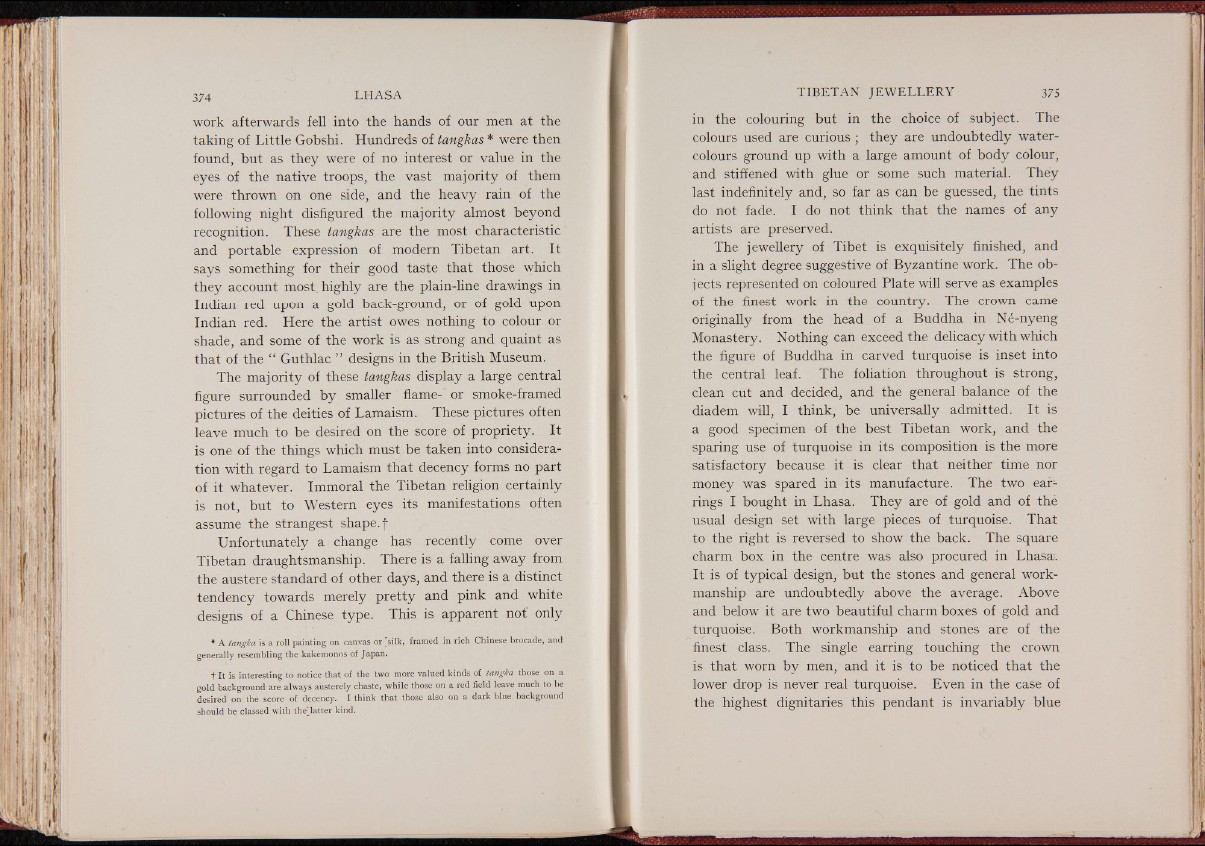
work afterwards fell into the hands of our men at the
taking of Little Gobshi. Hundreds of tangkas * were then
found, but as they were of no interest or value in the
eyes of the native troops, the vast majority of them
were thrown on one side, and the heavy rain of the
following night disfigured the majority almost beyond
recognition. These tangkas are the most characteristic
and portable expression of modern Tibetan art. It
says something for their good taste that those which
they account most, highly are the plain-line drawings in
Indian red upon a gold back-ground, or of gold upon
Indian red. Here the artist owes nothing to colour or
shade, and some of the work is as strong and quaint as
that of the “ Guthlac ” designs in the British Museum.
The majority of these tangkas display a large central
figure surrounded by smaller flame-' or smoke-framed
pictures of the deities of Lamaism. These pictures often
leave much to be desired on the score of propriety. It
is one of the things which must be taken into consideration
with regard to Lamaism that decency forms no part
of it whatever. Immoral the Tibetan religion certainly
is not, but to Western eyes its manifestations often
assume the strangest shape, f
Unfortunately a change has recently come over
Tibetan draughtsmanship. There is a falling away from
the austere standard of other days, and there is a distinct
tendency towards merely pretty and pink and white
designs of a Chinese type. This is apparent not' only
* A tangka is a roll painting on canvas or [silk, framed in rich Chinese brocade, and
generally resembling the kakemonos of Japan.
t* It is interesting to notice that of the two more valued kinds of tcmgkcL those on a
gold background are always austerely chaste, while those on a red field leave much to be
desired on thé score of decency. I think that those also on a dark blue background
should be classed with the'jatter kind.
in the colouring but in the choice of subject. The
colours used are curious ; they are undoubtedly watercolours
ground up with a large amount of body colour,
and stiffened with glue or some such material. They
last indefinitely and, so far as can be guessed, the tints
do not fade. I do not think that the names of any
artists are preserved.
The jewellery of Tibet is exquisitely finished, and
in a slight degree suggestive of Byzantine work. The objects
represented on coloured Plate will serve as examples
of the finest work in the country. The crown came
originally from the head of a Buddha in Né-nyeng
Monastery. Nothing can exceed the delicacy with which
the figure of Buddha in carved turquoise is inset into
the central leaf. The foliation throughout is strong,
clean cut and decided, and the general balance of the
diadem will, I think, be universally admitted. It is
a good specimen of the best Tibetan work, and the
sparing use of turquoise in its composition is the more
satisfactory because it is clear that neither time nor
money was spared in its manufacture. The two earrings
I bought in Lhasa. They are of gold and of thè
usual design set with large pieces of turquoise. That
to the right is reversed to show the back. The square
charm box in the centre was also procured in Lhasa.
It is of typical design, but the stones and general workmanship
are undoubtedly above the average. Above
and below it are two beautiful charm boxes of gold and
turquoise. Both workmanship and stones are of the
finest class. The single earring touching the crown
is that worn by men, and it is to be noticed that the
lower drop is never real turquoise. Even in the case of
the highest dignitaries this pendant is invariably blue